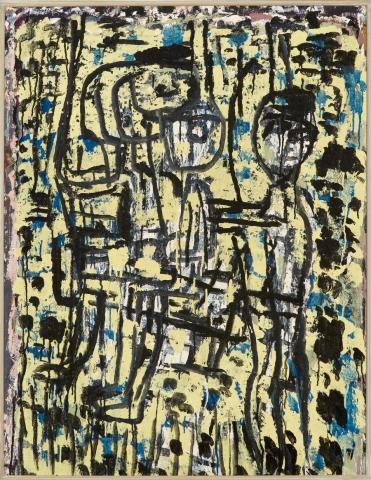FIGURE GROUP IV, 1970
Ian Fairweather
synthetic polymer paint and gouache on card on board
96.0 x 75.0 cm
inscribed verso: FIGURE GROUP IV (1970) / NO 15
Macquarie Galleries, Sydney
The Estate of Neville Gruzman, Sydney
Ian Fairweather, Macquarie Galleries, Sydney, 1970, cat. 15
Ian Fairweather Retrospective Exhibition, Queensland Art Gallery, Brisbane and touring venues, 1 October 1994 - 7 May 1995, cat. 61 (label attached verso)
Bail, M., Fairweather, Murdoch Books, Sydney, 2009 (revised edition), pp. 225, 260, cat. 228, pl. 198, p. 230 (illus.)
Bail, M. et. al., Ian Fairweather, Queensland Art Gallery, Brisbane, 1994, pl. 61 (illus.)
When Ian Fairweather's exhibition opened at the Macquarie Galleries, Sydney in late 1970, his recent paintings were hailed as 'master works by one of the most important painters of our time.'1 Painted at Bribie Island in Queensland, Figure Group IV was catalogue number 15 in the show. To put together such an exhibition at the age of 79 was a remarkable achievement in itself. The quality of the works themselves was further testimony to his standing, deeply enriched by long experience and single-minded devotion to his art, and not surprisingly, critics were unanimous in their praise. James Gleeson commented on the way in which Fairweather achieved individuality 'out of a combination of the Chinese and Western traditions.'2 John Henshaw, another artist-critic, observed that while 'The muted colors look eastern; nevertheless they are as local as the sand rocks and water around Bribie Island.'3 Some years later, Murray Bail, when summarising Fairweather's achievement in his fine monograph on the artist, cited Cubism, writing, 'His finest work was invariably a merging of all three: cubism, feint elements of Aboriginal art, the expressive form of the Chinese line.'4 Of the influence of oriental art, Fairweather said, 'The Chinese have quite a different idea of painting from us. The movement, the stroke of the hand counts so much for them. They never draw a straight line. And it's the same for me. It's given a sensitiveness towards line that I didn't have.'5 Although Fairweather was a figure painter, he was not a realist. Line was his way of escape. The brilliance of his calligraphy was such that it became a kind of celebration in its own right in the avoidance of solid form.
Figure Group IV, with all its freedom and command, is a masterly work of his old age, reminding one of the late achievements of other old masters in Australia such as Lloyd Rees, when inspiration transcends technique to touch upon the universal. In his late paintings Fairweather achieves an even deeper, inner balance between individuality and harmony. Like the paintings of all ageing maestros, these works contain many references to the past - figural, compositional, coloristic - but one cannot but wonder if the occasional present biographical reference is slipped in, for example in the seated figure attended by others. Their elusive outlines advance from the brilliant calligraphic tangle, sighted on the picture plane rather than receding into it. Linear forms echo. Perhaps, above all else it is the colour that catches the eye and moves the spirit. There is a new quality of hue - earthy pigments have been put aside for more transcendent colours, of blues, pinks and mauves of aerial quality, whites suggestively ethereal. Once again, it is the colour mastery of the limited palette. Significantly, Fairweather once said, 'I am more of a colourist than a draughtsman. I see things as colour first of all.'6 Overlapping line and colour, the considered brushstroke combined with the dribble of paint gives these works a strength, a profundity of statement and depth of being that is uniquely Fairweather.
1. Gleeson, J., 'The work of a master', Sun, Sydney, 28 October 1970, p. 56
2. ibid.
3. Henshaw, J., 'Detachment and Triumph', Australian, Sydney, 7 November 1970, p. 21
4. Bail, M., Fairweather, Murdoch Books, Sydney 2009, p. 237
5. Fairweather to Craig McGregor, Bribie Island, 1968, quoted Bail, op. cit., pp. 269-270
6. ibid., p. 269
DAVID THOMAS
